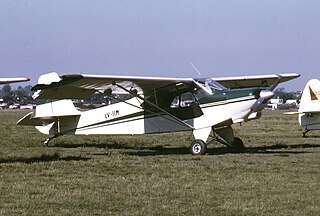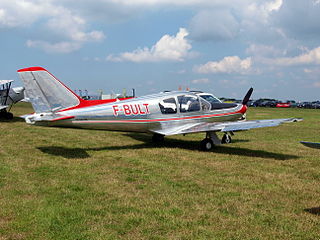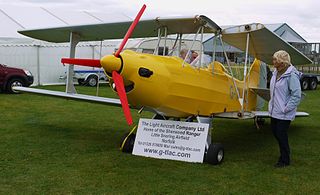
The Partenavia P.68, now Vulcanair P68, is a light aircraft designed by Luigi Pascale and initially built by Italian Partenavia. It made its first flight on 25 May 1970, its type certification was granted on 17 November 1971 and was transferred to Vulcanair in 1998. The original six-seat high-wing monoplane is powered by twin piston engines and is used for light transport and training. The P.68 Observer is an observation aircraft variant, and it was developed in a stretched, 10/11-seat twin turboprop derivative.

The Republic RC-3 Seabee is an all-metal amphibious sports aircraft designed by Percival Spencer and manufactured by the Republic Aircraft Corporation.

The Agusta A.101 was a large prototype transport helicopter developed in Italy during the 1960s. Despite prospective orders from the Italian armed forces, no buyers emerged and the project was abandoned in 1971.

The Partenavia P.64B/P.66B Oscar is an Italian two/four-seat, single-engined, high-wing monoplane built by Partenavia.

The Piaggio P.166 is an Italian twin-engine pusher-type utility aircraft developed by Piaggio Aero. The aircraft model name was Portofino, and is also known as Albatross in South African military service.

The PZL-105 Flaming (flamingo) is a Polish short-takeoff-and-landing (STOL) utility aircraft designed by PZL "Warszawa-Okęcie". It remained a prototype.

The Bölkow Bo 207 was a four-seat light aircraft built in West Germany in the early 1960s, a development of the Klemm Kl 107 built during World War II.

The Call-Air Model A is an American two- to three-seat utility aircraft designed by the Call brothers and built by the Call Aircraft Company, later developed into a successful line of agricultural aircraft.

The AS/SA 202 Bravo is a two to three-seat civil light aircraft jointly designed and manufactured by the Swiss company Flug- und Fahrzeugwerke Altenrhein (FFA) and the Italian company Savoia-Marchetti. The aircraft was designated the AS 202 in Switzerland, and the SA 202 in Italy.

The Funk Model B was a 1930s American two-seat cabin monoplane designed by Howard and Joe Funk. Originally built by the Akron Aircraft Company later renamed Funk Aircraft Company.
The Mráz M-2 Skaut was a Czechoslovakian wooden two-seat, single engine, low wing sports aircraft of the late 1940s. In 2005 the design was revisited, resulting in the metal framed, modernised Scout which first flew in 2009 with plans for production and first deliveries in 2011.

The Robin HR100 is a French four-seat light monoplane, designed by Chris Heintz and built by Avions Pierre Robin as metal-winged version of the Robin DR253 Regent.

The Thurston Teal is a family of two- and four-seat all-aluminium amphibious aircraft designed by David Thurston in the United States and first flown in 1968.

The DINFIA IA 46 Ranquel, IA 46 Super Ranquel, and IA 51 Tehuelche were Argentine utility aircraft developed in the late 1950s.

The Nardi FN.333 Riviera, later the SIAI-Marchetti FN.333 Riviera, is an Italian luxury touring amphibious aircraft designed and developed by Fratelli Nardi in the 1950s and produced in small numbers by Savoia-Marchetti during the following decade.

The Procaer F.15 Picchio is an Italian-designed light utility aircraft built by Procaer.

The Ambrosini Rondone is an Italian-designed two/three-seat light touring monoplane of the early 1950s.

The Tiger Cub Developments (TCD) Sherwood Ranger is a single engine, tandem two seat biplane microlight designed and built in the United Kingdom in the early 1990s. Kits were originally produced by TCD; later, design rights were acquired by The Light Aircraft Company Ltd (TLAC) who resumed kit production in 2009.

The Trident TR-1 Trigull is a Canadian amphibious aircraft that was developed by Trident Aircraft of Burnaby, British Columbia and later Sidney, British Columbia. The aircraft was intended to be supplied as a complete ready-to-fly certified aircraft. The company encountered financial difficulties and only three prototypes were ever built.

The Uetz Pelikan is a Swiss four-seat cabin monoplane designed for amateur construction by Walter Uetz.




















